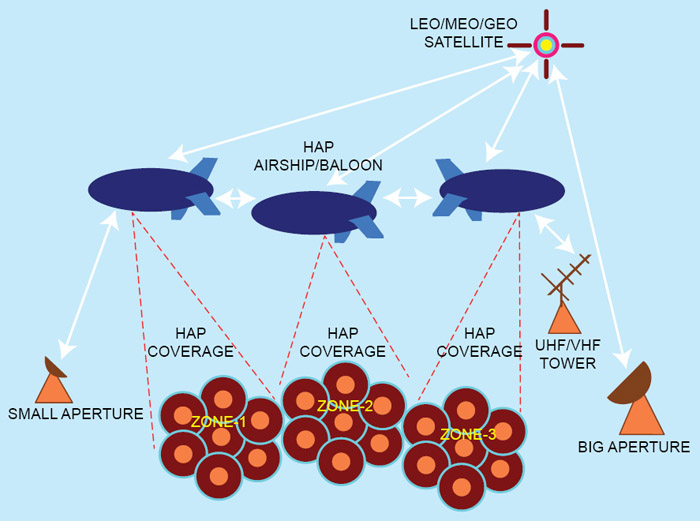Because of a high demand for various types of communication services, wireless solutions are becoming increasingly important. Next-generation wireless communication with high data rate and multimedia services needs broadband wireless access. Wireless broadband multimedia services will provide a convergence of telecommunication, TV, Internet, video-on-demand, etc.
Satellite systems can be used for broadband personal communications through mobile and fixed wireless communication devices. Satellite offers a moderate capacity and is mostly used by corporate users. But, because of the high cost and high signal attenuation in satellite communication, it is very difficult to use satellite services for general public communication purposes.

An alternative to terrestrial and satellite infrastructure, using high-altitude platform (HAP) in stratospheric altitude, was first proposed in 1992. Broadband wireless communication using HAP is a low-cost and an easily deployable satellite service, where HAP is placed at a lower altitude of atmosphere (stratosphere) than a satellite orbit. Geostationary earth orbit (GEO), low-earth orbit (LEO) or medium-earth orbit (MEO) satellites can be used for onboard processing in HAP communication. The satellite can use forward channel towards user terminals (fixed or mobile), control and management stations, and HAP or a set of HAPs.
There are several advantages of broadband communication using HAP, including easy deployment, lower cost of operation than satellite communication, point-to-point and point-to-multipoint communication, easy maintainance, low path loss, high elevation and hence wide coverage area, flexibility, reconfigurability, mobility and lighter payload.
HAP architecture
HAP can take any form such as a balloon, a powered unmanned airship or a powered manned aeroplane that keeps station in the winds (that is, floating or quasi-stationed) at a high altitude of 18-25 km. International Telecommunication Union (ITU) has recommended 28GHz and 31GHz frequency bands for HAP communications.
The basic architecture of HAP is shown in Fig. 1. Satellite signal is downloaded by the HAP, placed at an altitude of 18–25 km. The signal is communicated to the user terminals on the earth. Each HAP covers a wide zone (like zone 1, zone 2 and zone 3, as shown in Fig. 1) and each zone is divided into smaller cells. Channel allocation in different cells within a zone uses frequency reuse technique (where the same frequency is used after a certain spatial separation). One HAP may communicate with another HAP covering another zone. HAP acts as a hub for communication. Altitude of 18-25 km is chosen because the average wind speed at this height is minimum and the coverage of the antennae can be a footprint of up to 80km diameter with HAP altitude of 20 km, resulting in a cellular service for a large number of users over a wide area. The variation of wind speed with altitude is shown in Fig. 2.






